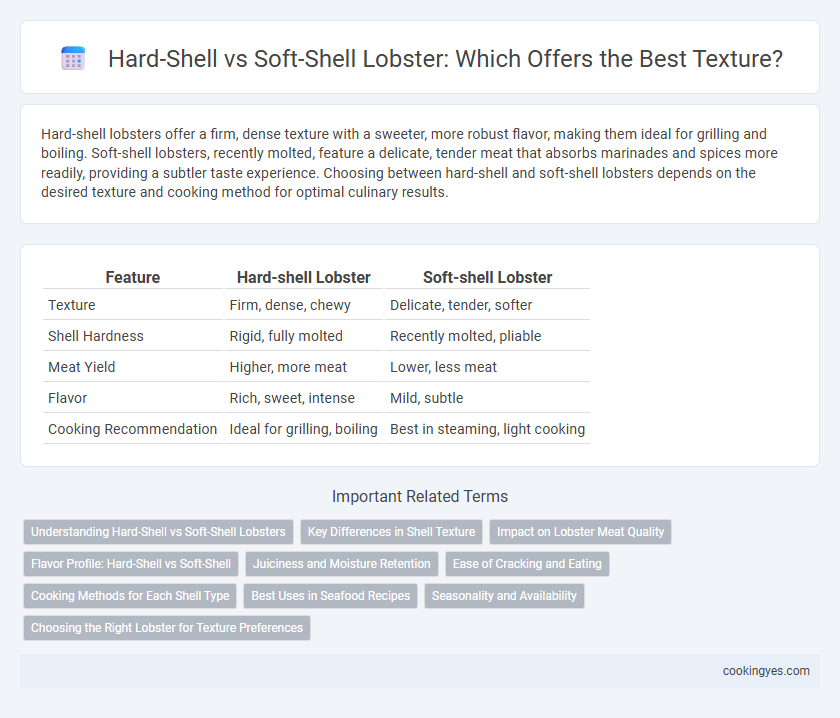Hard-shell lobsters offer a firm, dense texture with a sweeter, more robust flavor, making them ideal for grilling and boiling. Soft-shell lobsters, recently molted, feature a delicate, tender meat that absorbs marinades and spices more readily, providing a subtler taste experience. Choosing between hard-shell and soft-shell lobsters depends on the desired texture and cooking method for optimal culinary results.
Table of Comparison
| Feature | Hard-shell Lobster | Soft-shell Lobster |
|---|---|---|
| Texture | Firm, dense, chewy | Delicate, tender, softer |
| Shell Hardness | Rigid, fully molted | Recently molted, pliable |
| Meat Yield | Higher, more meat | Lower, less meat |
| Flavor | Rich, sweet, intense | Mild, subtle |
| Cooking Recommendation | Ideal for grilling, boiling | Best in steaming, light cooking |
Understanding Hard-Shell vs Soft-Shell Lobsters
Hard-shell lobsters offer a firmer, meatier texture and are typically harvested later in the molting cycle, providing more meat yield but less tenderness. Soft-shell lobsters have recently molted, featuring a softer exoskeleton and a more delicate, sweeter flavor with higher moisture content, though their meat quantity is slightly reduced. Choosing between hard-shell and soft-shell lobsters depends on desired texture and culinary application, with hard-shell preferred for grilling and soft-shell ideal for steaming or boiling.
Key Differences in Shell Texture
Hard-shell lobsters feature a dense, rigid exoskeleton that provides greater protection and longer harvest intervals between molts, resulting in firmer, meatier texture. Soft-shell lobsters, having recently molted, possess a thinner, more flexible shell with still tender meat but higher moisture content, often leading to a sweeter flavor. The key difference in shell texture directly influences cooking methods and culinary applications, with hard-shell preferred for durability and soft-shell favored for delicacy.
Impact on Lobster Meat Quality
Hard-shell lobsters offer denser, firmer meat with a slightly sweeter flavor due to longer molting intervals, enhancing texture quality preferred in gourmet dishes. Soft-shell lobsters, recently molted, provide more tender meat but with higher moisture content, resulting in a delicate, less fibrous texture ideal for steaming or quick cooking. The shell hardness directly influences meat composition, affecting juiciness, flavor intensity, and overall eating experience.
Flavor Profile: Hard-Shell vs Soft-Shell
Hard-shell lobsters offer a firmer, meatier texture with a more pronounced, briny flavor due to their denser exoskeleton that retains natural juices better. Soft-shell lobsters, recently molted, have a tender, delicate texture with a milder, sweeter taste, often absorbing sauces and seasonings more readily. The choice between hard-shell and soft-shell directly impacts the lobster's flavor intensity and mouthfeel, influencing preparation methods and culinary pairings.
Juiciness and Moisture Retention
Hard-shell lobsters have a firmer texture with a more concentrated flavor due to lower moisture content, while soft-shell lobsters offer a juicier, more tender bite thanks to higher moisture retention during their molting phase. The exoskeleton hardness directly influences texture; hard shells encase dense, less hydrated meat, whereas soft shells contain meat that holds more natural juices, enhancing succulence. Moisture retention in soft-shell lobsters results in a more delicate mouthfeel, making them preferable for dishes emphasizing freshness and tenderness.
Ease of Cracking and Eating
Hard-shell lobsters have a firmer, denser texture and require more effort to crack through their tough exoskeleton, making the eating process slightly more time-consuming but rewarding with meat that holds its shape well. Soft-shell lobsters, having recently molted, feature a thinner, more fragile shell that is much easier to crack open, speeding up consumption though the meat may be less firm and slightly more delicate in texture. Choosing between hard-shell and soft-shell lobsters depends on preference for ease of cracking versus the desired meat texture during eating.
Cooking Methods for Each Shell Type
Hard-shell lobsters require longer cooking times, typically steamed or boiled for 12-15 minutes per pound to fully develop their firm, dense meat texture. Soft-shell lobsters, recently molted and with a thinner exoskeleton, benefit from shorter cooking methods like grilling or broiling for 6-8 minutes, preserving their tender and delicate flavor. Precise heat control ensures optimal texture retention for both shell types, enhancing the culinary experience.
Best Uses in Seafood Recipes
Hard-shell lobster offers firm, dense meat ideal for grilling, broiling, or boiling, maintaining its texture in hearty dishes like lobster bisque or lobster rolls. Soft-shell lobster provides tender, sweet meat perfect for steaming or sauteing, lending itself well to delicate recipes such as lobster salad or pasta. Choosing between hard-shell and soft-shell lobsters depends on the desired texture and cooking method to enhance specific seafood dishes.
Seasonality and Availability
Hard-shell lobsters are most abundant during late summer and early fall when their shells have fully hardened, offering a firmer and meatier texture prized by chefs. Soft-shell lobsters, which have recently molted and shed their hard exoskeleton, are typically available in late spring and early summer, providing a sweeter and more tender meat but with a shorter shelf life. Seasonal availability impacts market prices, with hard-shell lobsters often commanding higher value due to their durability and longer storage potential.
Choosing the Right Lobster for Texture Preferences
Hard-shell lobsters have a firm, dense texture preferred by those who enjoy a chewy bite and intense lobster flavor, as their shells have hardened after molting. Soft-shell lobsters, freshly molted with thinner shells, offer a sweeter taste and more tender meat, ideal for diners seeking a delicate, buttery texture. Selecting between hard-shell and soft-shell lobsters depends on whether you prioritize robustness or tenderness in the lobster's texture.
Hard-shell vs Soft-shell for lobster texture Infographic

 cookingyes.com
cookingyes.com